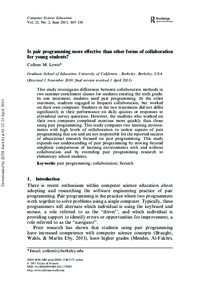Is pair programming more effective than other forms of collaboration for young students? Publikationsdatum:
Zu finden in: Computer Science Education 2/2011 (Seite 105 bis 134), 2011
|
 |
 Diese Seite wurde seit 3 Jahren inhaltlich nicht mehr aktualisiert.
Unter Umständen ist sie nicht mehr aktuell.
Diese Seite wurde seit 3 Jahren inhaltlich nicht mehr aktualisiert.
Unter Umständen ist sie nicht mehr aktuell.
 Zusammenfassungen
Zusammenfassungen
 Pair-Programming führt gemäss dieser Studie zu ähnlich guten Lernerfolgen wie andere kooperative Lernformen aber dafür sind die Lernenden weniger von Informatik begeistert (evtl. weil sie in ihrem Flow gebremst werden).
Pair-Programming führt gemäss dieser Studie zu ähnlich guten Lernerfolgen wie andere kooperative Lernformen aber dafür sind die Lernenden weniger von Informatik begeistert (evtl. weil sie in ihrem Flow gebremst werden).This study compared two highly collaborative learning environments to
isolate aspects of pair programming that are influential for supporting
students’ understanding, attitudes and interest in computer science, and
pace. There were no statistically significant differences between students’
performance on daily quizzes; however, there was greater variation in
performance on daily quizzes for students using pair programming. There
were no statistically significant differences between students’ responses to
attitudinal survey questions; however, students who used pair programming
were slightly less positive for survey questions related to interest in
computer science. Students who worked on their own computers
completed exercises more quickly, but it was not feasible to validate if
the quality of students’ work was similar between the two treatments.
Von Colleen M. Lewis im Journal Computer Science Education 2/2011 im Text Is pair programming more effective than other forms of collaboration for young students? (2011) This study investigates differences between collaboration methods in two summer enrichment classes for students entering the sixth grade. In one treatment, students used pair programming. In the other treatment, students engaged in frequent collaboration, but worked ontheir own computer. Students in the two treatments did not differ significantly in their performance on daily quizzes or responses to attitudinal survey questions. However, the students who worked on their own computer completed exercises more quickly than those using pair programming. This study compares two learning environments with high levels of collaboration to isolate aspects of pair programming that are and are not responsible for the reported success of educational research focused on pair programming. This study expands our understanding of pair programming by moving beyond simplistic comparisons of learning environments with and without collaboration and by extending pair programming research to elementary school students.
Von Colleen M. Lewis im Journal Computer Science Education 2/2011 im Text Is pair programming more effective than other forms of collaboration for young students? (2011)  Dieser wissenschaftliche Zeitschriftenartikel erwähnt ...
Dieser wissenschaftliche Zeitschriftenartikel erwähnt ...
 Dieser wissenschaftliche Zeitschriftenartikel erwähnt vermutlich nicht ...
Dieser wissenschaftliche Zeitschriftenartikel erwähnt vermutlich nicht ... 
 Nicht erwähnte Begriffe | Einzelarbeit, Informatik-Didaktik, Informatikunterricht in der Schule, Kinder, LehrerIn, Unterricht |
 Tagcloud
Tagcloud
 Zitationsgraph
Zitationsgraph
 Zitationsgraph (Beta-Test mit vis.js)
Zitationsgraph (Beta-Test mit vis.js)
 Zeitleiste
Zeitleiste
 3 Erwähnungen
3 Erwähnungen 
- ICER 2012 - International Computing Education Research Conference, ICER '12, Auckland, New Zealand, September 10-12, 2012 (Alison Clear, Kate Sanders, Beth Simon) (2012)
- The importance of students' attention to program state - a case study of debugging behavior (Colleen M. Lewis) (2012)


- The importance of students' attention to program state - a case study of debugging behavior (Colleen M. Lewis) (2012)
- ICER 2014 - International Computing Education Research Conference, ICER 2014, Glasgow, United Kingdom, August 11-13, 2014 (Quintin I. Cutts, Beth Simon, Brian Dorn) (2014)
- Computational thinking curriculum development for upper elementary school classes (Charlotte Hill) (2014)


- Computational thinking curriculum development for upper elementary school classes (Charlotte Hill) (2014)
- ICER 2015 - Proceedings of the eleventh annual International Conference on International Computing Education Research, ICER 2015, Omaha, NE, USA, August 09 - 13, (Brian Dorn, Judy Sheard, Quintin I. Cutts) (2015)
- How Equity and Inequity Can Emerge in Pair Programming (Colleen M. Lewis, Niral Shah) (2015)


- How Equity and Inequity Can Emerge in Pair Programming (Colleen M. Lewis, Niral Shah) (2015)
 Anderswo finden
Anderswo finden
 Volltext dieses Dokuments
Volltext dieses Dokuments
 |  Is pair programming more effective than other forms of collaboration for young students?: Artikel als Volltext ( Is pair programming more effective than other forms of collaboration for young students?: Artikel als Volltext ( : :  , 1475 kByte; , 1475 kByte;  : :  2021-03-21) 2021-03-21) |
 Anderswo suchen
Anderswo suchen 
 Beat und dieser wissenschaftliche Zeitschriftenartikel
Beat und dieser wissenschaftliche Zeitschriftenartikel
Beat hat Dieser wissenschaftliche Zeitschriftenartikel während seiner Zeit am Institut für Medien und Schule (IMS) ins Biblionetz aufgenommen. Beat besitzt kein physisches, aber ein digitales Exemplar. Eine digitale Version ist auf dem Internet verfügbar (s.o.). Es gibt bisher nur wenige Objekte im Biblionetz, die dieses Werk zitieren.









 LOGO (Programmiersprache)
LOGO (Programmiersprache) pair programming
pair programming Partnerarbeit
Partnerarbeit Primarschule (1-6) / Grundschule (1-4)
Primarschule (1-6) / Grundschule (1-4) Programmieren
Programmieren Schule
Schule Scratch
Scratch






 Biblionetz-History
Biblionetz-History